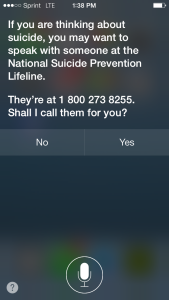Crisis Intervention
now browsing by tag
Crisis Intervention Technology Spotlight: Telemental Health and NAASP

Crisis intervention technology continues to leverage Web and mobile space, leading to improvements in service efficiency and reach. Increasingly, organizations such as the National Action Alliance for Suicide Prevention (NAASP) are reviewing tele-medical strategies for suicide prevention.
About NAASP
The National Action Alliance for Suicide Prevention (NAASP) has a lofty vision: a nation free from the tragic experience of suicide. The organization hopes to save 20,000 lives between 2010 when the nation was founded and 2015.
To complete actualize its vision, NAASP created Zero Suicide Advisory Group. Zero Suicide is NAASP’s strategy of expanding suicide prevention in healthcare systems. Its primary concern is patient safety.
The strategy comprises six components:
- Creating a culture of zero suicide by confronting the culture of pessimism and hopelessness in healthcare organizations regarding making any real progress in suicidal cases.
- Ensuring every person has a pathway to care by providing screening tools and promoting screening options.
- Developing a competent workforce by training healthcare providers to handle situations involve suicide.
- Identifying and assessing risk level during primary care.
- Using effective, evidence-based care by employing data-backed studies that indicate that suicidal ideation should be treated directly and not as a symptom to a problem.
- Continuing contact after care by providing critical follow-up interventions to ensure the ongoing safety of patients.
Virtual/Remote Suicide Prevention
One way that NAASP will carry out its suicide-prevention goals is technology-based care. This involves administering crisis intervention services remotely.
According to NAASP, virtual or remote care can keep give suicidal persons constant access to help throughout all hours of the day and night. This involves multiple crisis intervention strategies, including existing strategies of phone lines, emerging strategies including text and chat, and developing strategies including telecounseling, online video counseling, and self-assessment.
According to a 2013 report published by the American Telemedicine Association (ATA), telemental health is one of the most active telemedicine applications rendered in the United States. The service delivery strategy is efficient and allows clinicians to broaden their reach to patients. Telemental health can even be delivered over mobile devices – an extremely fast growing method of communication.
It may be that, in the future, telemental health and crisis intervention services will work more closely together. Where in the past, crisis intervention services could only be accessed from a phone, now a person can only speak, text, and chat with a crisis counselor via mobile phone, but also teleconference with a professional clinician as well. Further, all of this can take place in a short amount of time, and for less cost to the client than ever before.
Crisis Intervention Technology Round-Up

Technology is changing the game in crisis intervention. Innovative organizations are continually finding new ways to reach larger audience.
Here’s how some prominent crisis intervention organizations are using crisis intervention technology to great effectiveness:
Emotion Technology Looks to the Next Generation
Emotion Technology CEO Christopher Gandin Le recently publish an article in the Huffington Post stating that the future of suicide prevention rests on the new ideas of young people and new technology.
“I’ve reached the limit to what I can imagine as one person,” said Le. “ It’s time for people who are far smarter than me and far less experienced in doing this work to innovate.”
Siri Helps Prevent Suicide
Telling your iPhone assistant that you are thinking about hurting yourself now leads to automated intervention on behalf of Siri.
The voice-activated software responds to several similar commands, such as “I want to jump off a bridge,” and refers the National Suicide Prevention hotline number to the user. Could a direct connection to a Crisis Chat channel be the next feature in store?

NSPL Steps Up its Content Creation
Many crisis interventions organizations are stepping up their content creation game to reach audiences where they are – the Web.
Lifeline’s stylish blog titled You Matter looks fantastic and is extremely readable. There are several dozen posts for audiences who are in crisis or may be worried about someone else in crisis. Self-care tips, positive message, and tutorials are common themes for the blog.
Veteran’s Crisis Hotline Goes Mainstream
The highly successful Veteran’s Crisis Line (hotline, online chat & text) has garnered considerable attention from major media companies.
HBO’s documentary Crisis Hotline: Veterans Press 1 spotlights the traumas endured by America’s veterans as seen through the eyes of the crisis counselors who take the calls and chats.
Additionally, NPR published an article in September 2013 about the veteran’s service which describes the stories soldiers share with the hotline. The article features four hotline employees who share their experiences with StoryCorps, — an American non-profit organization whose mission is to tell the stories of Americans from all backgrounds and belief.
Have an idea for a crisis intervention technology project? We’d love to hear about it! Contact us today.
13 Must-Have Resources for HIPAA Compliance for Crisis Centers

Worried about HIPAA compliance for crisis centers? As crisis centers and I&R service providers advance, data privacy typically becomes a larger concern.
As crisis centers advance in their mission and adopt new programs, many are wising up to data hazards. For instance, did you know that an organization that simply stores the data of a health organization is subject to PHI regulation? For more information on how crisis centers are insuring against privacy violations, see our earlier blog posts about trends in I&R.
For a complete data-security audit, you’ll need legal and expert assistance. However, there are some steps you can take on your own to mitigate risk. Use these 13 resources HIPAA Compliance for Crisis Centers to maintain data privacy for your valuable information:
Breach notification readiness
For many organizations, it’s not if you’ll have a breach, but when. Know what to do when a breach happens and mitigate the negative consequences as much as possible:
AMA Breach Notification publication: Comprehensive breach notification guide for physicians, most of which applies for crisis centers.
HHS Breach Portal: Comprehensive resource portal for everything regarding data breaches according to HHS.
Legislation/Government
These publications include complete legislation in regards to HIPAA. Lots of pages, but if you’re doing an in-depth analysis, you’ll need these.
45 CFR Parts 160 and 164. Government document describing HIPAA.
HIPAA Homesite. Everything you (or more likely your lawyer) needs to know about HIPAA.
News
Like most legislation, HIPAA changes over time. Keep track of changes on the Web and through social media.
HHS “What’s New” homesite. Likely, this will be the first place to publish news about HIPAA changes.
Social Media Feed (Twitter) @hippanews.
Technology
Aside from training, technology resources are powerful tools for improving data security.
Sonicwall Email security. Email scrubbers help to prevent PHI from getting accidentally sent to non-authorized persons. There are lots of products for this and shopping is recommended; however we have listed the Sonicwall version here.
HHS Technology resources. HHS-endorsed technology solutions portal.
Tools
Here are a few handy items for data compliance.
Automated compliance checker. Questionnaire estimates your risk-level based on some basic-level questions.
Product marketplace. Portal with an assortment of HIPAA-related electronic items, such as training programs.
Training
As stated, training is your first line of defense against breaches. Build your own training curriculum, or purchase a tried-and-true training package from one of the following portals:
HIPAA Training videos. HHS-recommended training resources.
Online training courses. An assortment of Web training curriculums that should be considered when developing a training program.
BONUS RESOURCE FOR RESEARCHERS
We promised you thirteen resources, but here’s a fourteenth essential resource, on the house. While this page doesn’t include much in the way of data privacy, it is nonetheless a helpful repository of statistics about drug addiction.
Profile of addiction by profession data resource. Interactive research tool about substance abuse.
Have any more questions about training? Contact us today!
